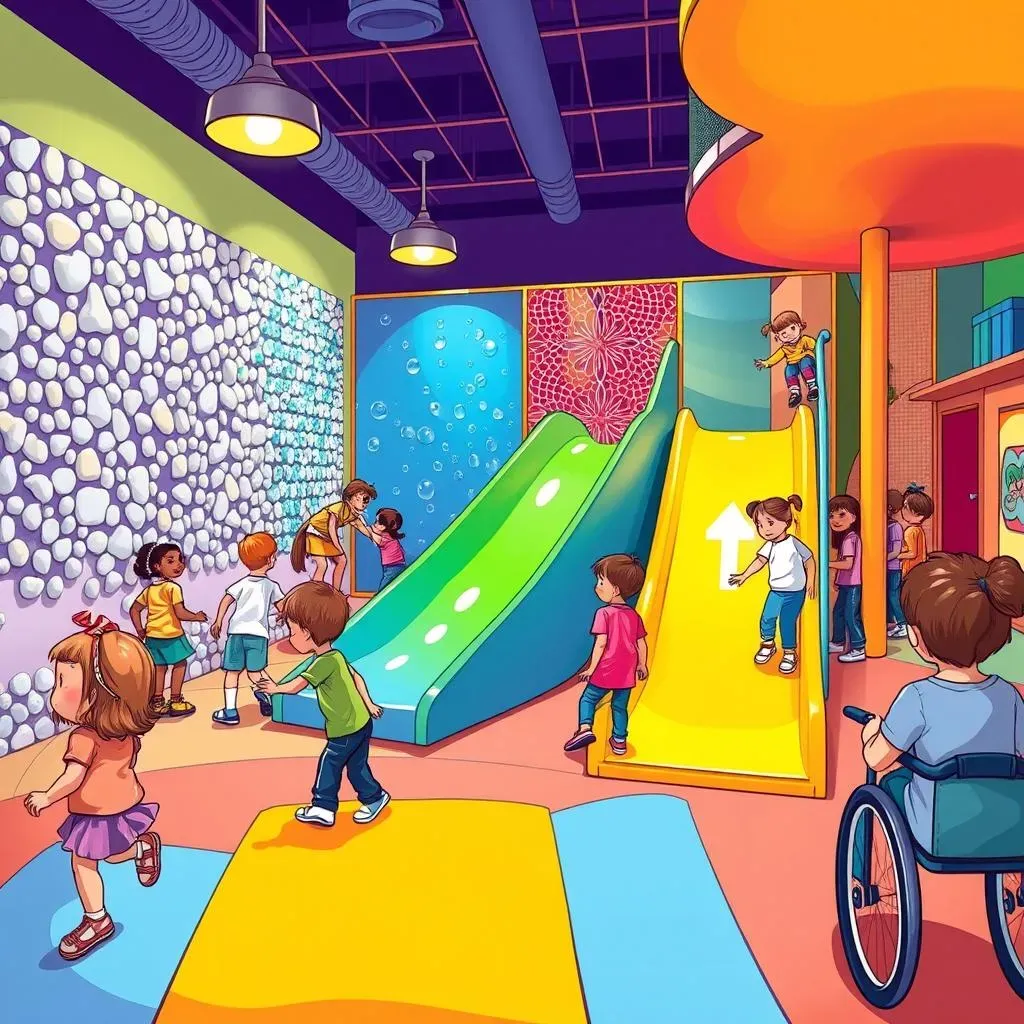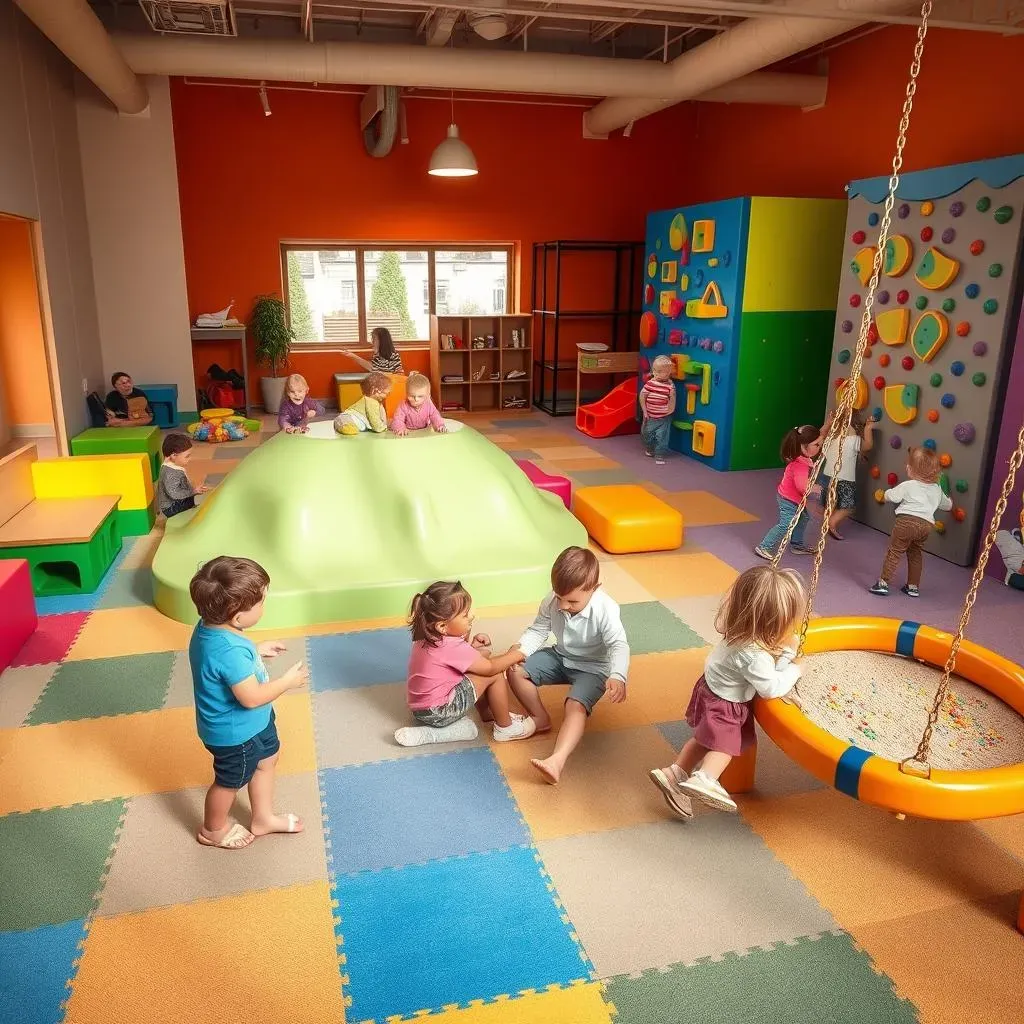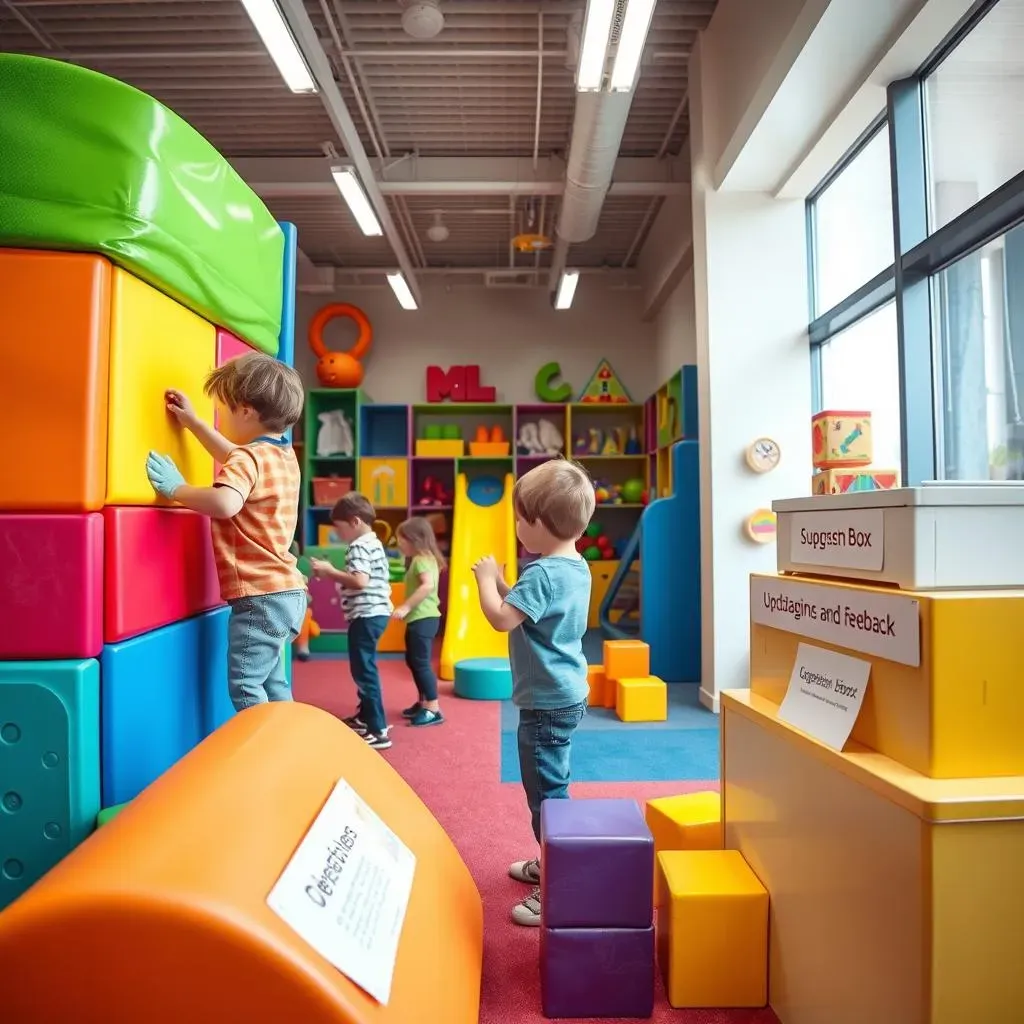Table of Contents
Ever wondered how to create a play space that's not only fun but also incredibly beneficial for a child's development? Welcome to the world of indoor sensory playground equipment, where play meets therapy and learning. These aren't your average playgrounds; they're carefully designed environments that stimulate a child's senses, encouraging exploration, creativity, and crucial developmental skills. In this guide, we'll dive deep into what makes indoor sensory playground equipment so special. We'll explore the core elements that form these engaging spaces, offering insights into how each piece of equipment contributes to sensory integration. Whether you're a parent, educator, or therapist, you'll discover practical tips for designing your own sensory-rich environment. From selecting the right equipment to understanding the specific needs of different children, we'll cover everything you need to know. Plus, we'll share essential maintenance tips to ensure your indoor sensory playground equipment remains a safe and stimulating space for years to come. Get ready to unlock the potential of play and create an environment where children of all abilities can thrive.
Understanding Indoor Sensory Playgrounds and Their Benefits

Understanding Indoor Sensory Playgrounds and Their Benefits
What is an Indoor Sensory Playground?
Imagine a playground that's not just about climbing and sliding, but about engaging all the senses. That's the essence of an indoor sensory playground. It's a carefully designed space filled with equipment and activities that stimulate sight, sound, touch, smell, and even taste. These playgrounds are created with the intent of fostering exploration, learning, and development in a safe and controlled environment, away from the unpredictable elements of the outdoors.
Unlike traditional playgrounds, sensory playgrounds prioritize inclusivity. They're designed to cater to children of all abilities, including those with sensory processing disorders, autism, and other developmental challenges. By providing a variety of sensory experiences, these playgrounds help children regulate their sensory input, improve their motor skills, and enhance their social interactions.
The Developmental Benefits of Sensory Play
The benefits of indoor sensory playgrounds extend far beyond just fun and games. Sensory play is crucial for brain development, helping children build neural pathways that support learning, problem-solving, and creativity. By engaging with different textures, sounds, and sights, children develop their sensory processing skills, allowing them to better understand and interact with the world around them.
Moreover, sensory play can have a calming and therapeutic effect. For children with sensory sensitivities, these playgrounds provide a safe space to explore and regulate their sensory input. Activities like swinging, jumping, and tactile exploration can help reduce anxiety, improve focus, and promote emotional well-being. The controlled environment of an indoor sensory playground allows for tailored experiences that meet each child's unique needs.
Key Components of Effective Indoor Sensory Playground Equipment

Key Components of Effective Indoor Sensory Playground Equipment
So, you're diving into the world of indoor sensory playgrounds? Awesome! Let's talk about what really makes them tick. It's not just about throwing a bunch of colorful stuff together; it's about creating a cohesive and stimulating environment. Think of it as curating an experience that caters to a wide range of sensory needs. We're talking about equipment that engages the vestibular, proprioceptive, tactile, visual, and auditory senses, all working together to create a truly immersive play space.
First off, you've got to consider the variety of equipment. A truly effective sensory playground incorporates elements that encourage movement, like swings and slides, alongside tactile experiences, such as textured walls and sandboxes (or, you know, a cleaner, indoor-friendly alternative!). Visual stimulation can come from bubble walls, light projections, or even just strategically placed colorful objects. And don't forget auditory elements – musical instruments, sound tubes, or even just a designated quiet area can make a huge difference. The key is balance and intentionality.
- Variety of Equipment: Swings, slides, textured walls, light projections, musical instruments.
- Accessibility: Ensure all children, regardless of ability, can access and enjoy the equipment.
- Safety: Prioritize safety with soft flooring, padded surfaces, and regular maintenance.
- Adaptability: Choose equipment that can be easily modified or adjusted to meet individual needs.
- Thematic Consistency: Consider a unifying theme to create a cohesive and engaging environment.
Accessibility is also key. A sensory playground should be inclusive, meaning that children of all abilities can participate and benefit. This might involve ramps, wider pathways, or equipment designed to be used by children with mobility challenges. Safety is another non-negotiable. Soft flooring, padded surfaces, and regular inspections are essential to prevent injuries and ensure a safe play environment. Think about it – you want kids to explore and experiment, not end up in the emergency room!
Finally, don't underestimate the power of adaptability. The best sensory playgrounds are flexible and can be easily modified to meet the changing needs of the children who use them. This might involve swapping out equipment, adjusting the lighting, or even just rearranging the layout. By creating a dynamic and responsive environment, you can ensure that your sensory playground remains a stimulating and engaging space for years to come.
Designing Your Own Indoor Sensory Playground: Tips and Considerations

Designing Your Own Indoor Sensory Playground: Tips and Considerations
Assessing Needs and Setting Goals
Alright, so you're ready to create your own indoor sensory playground? That's fantastic! But before you start ordering equipment and painting walls, let's take a step back and think about the kids who will be using the space. What are their specific sensory needs? Are you catering to children with autism, sensory processing disorders, or a mix of abilities? Understanding your audience is crucial for creating a playground that truly meets their needs.
Start by observing the children you're designing for. What types of sensory input do they seem to crave? Are they drawn to bright colors, loud noises, or specific textures? What activities seem to calm them down or engage them the most? Talk to parents, teachers, or therapists who work with these children to get their insights and recommendations. Once you have a clear understanding of their needs, you can set specific goals for your sensory playground. What skills do you want to promote? What behaviors do you want to encourage? By setting clear goals, you can ensure that your playground is not only fun but also therapeutic and educational.
Space Planning and Layout Design
so you know your audience and you've set your goals. Now it's time to think about the physical space. How much room do you have to work with? What are the existing features of the space, such as windows, doors, and electrical outlets? Creating a functional and engaging sensory playground requires careful planning and layout design. Think about how children will move through the space and how different areas can be used for different activities.
Consider creating distinct zones for different types of sensory input. For example, you might have a quiet zone with soft lighting, comfortable seating, and calming sounds. You could also have an active zone with swings, slides, and climbing equipment. A tactile zone could feature textured walls, sandboxes, or water tables. And don't forget about a visual zone with colorful objects, light projections, or bubble walls. By creating distinct zones, you can provide a variety of sensory experiences and allow children to choose the activities that best meet their needs. Also, ensure clear pathways and avoid overcrowding to prevent accidents and promote a sense of calm.
Zone Type | Sensory Input | Example Activities |
|---|---|---|
Quiet Zone | Calming Sounds, Soft Lighting | Reading, Listening to Music, Resting |
Active Zone | Vestibular, Proprioceptive | Swinging, Sliding, Jumping |
Tactile Zone | Touch, Texture | Sand Play, Water Play, Textured Walls |
Visual Zone | Sight, Color | Bubble Walls, Light Projections, Colorful Objects |
Selecting the Right Equipment and Materials
Now for the fun part: choosing the equipment and materials that will bring your sensory playground to life! With so many options available, it can be overwhelming to know where to start. The key is to select equipment that is safe, durable, and appropriate for the age and abilities of the children you're designing for. Consider a mix of equipment that stimulates different senses and encourages a variety of activities.
For tactile stimulation, think about textured mats, soft fabrics, and sensory bins filled with materials like rice, beans, or water beads. Visual stimulation can come from colorful lights, bubble tubes, or projectors that display calming images. Auditory stimulation can be provided by musical instruments, sound panels, or even just a simple sound machine with nature sounds. And don't forget about vestibular and proprioceptive input, which can be achieved with swings, slides, climbing structures, and balance beams. Prioritize natural and non-toxic materials whenever possible to create a healthy and safe environment for children. Remember to check safety ratings and guidelines to ensure compliance with industry standards.
Selecting the Right Indoor Sensory Playground Equipment for Different Needs

Selecting the Right Indoor Sensory Playground Equipment for Different Needs
Understanding Sensory Processing Differences
Not every child experiences the world in the same way. Sensory processing differences mean that some kids might be hypersensitive (easily overwhelmed) while others are hyposensitive (seeking more intense input). Understanding these differences is the first step in selecting the right indoor sensory playground equipment. For example, a child with tactile defensiveness might dislike certain textures, while a child with low muscle tone might benefit from equipment that provides proprioceptive feedback (like weighted vests or compression swings).
It's also important to consider any specific diagnoses, such as autism, ADHD, or sensory processing disorder. Each condition comes with its own set of sensory challenges and preferences. A child with autism might benefit from a quiet, predictable space with limited visual stimuli, while a child with ADHD might thrive in a more active and stimulating environment. By tailoring your equipment choices to the individual needs of the children you're serving, you can create a sensory playground that is both enjoyable and therapeutic.
Matching Equipment to Specific Needs
so you've got a handle on sensory processing differences. Now, how do you translate that knowledge into equipment choices? Let's break it down. For kids who are hypersensitive, focus on creating a calming and predictable environment. Soft lighting, muted colors, and quiet spaces are essential. Equipment like bubble tubes, weighted blankets, and gentle swings can provide soothing sensory input without being overwhelming. On the other hand, children who are hyposensitive might benefit from equipment that provides more intense sensory experiences. Think bright colors, loud noises, and activities that involve a lot of movement. Climbing walls, trampolines, and textured surfaces can help these kids get the sensory input they crave.
Remember, safety is always paramount. Choose equipment that is age-appropriate, well-maintained, and designed to minimize the risk of injury. Consider the weight capacity of swings and climbing structures, and always supervise children while they are using the playground. By prioritizing safety, you can create a sensory playground that is both fun and secure.
Creating Adaptable and Inclusive Play Spaces
The best sensory playgrounds are adaptable and inclusive, meaning that they can be used by children of all abilities. This might involve choosing equipment that can be easily modified or adjusted to meet individual needs. For example, a swing with adjustable height can be used by children of different sizes and abilities. A climbing wall with different levels of difficulty can provide a challenge for children with varying motor skills.
It's also important to consider accessibility. Ensure that children with mobility challenges can access all areas of the playground. Ramps, wider pathways, and adaptive equipment can help to create a truly inclusive environment. And don't forget about social interaction. Sensory playgrounds should encourage children to play together, learn from each other, and develop their social skills. Consider incorporating equipment that promotes collaboration and communication, such as group swings, interactive sound panels, or even just a comfortable seating area where children can relax and chat.
Sensory Need | Equipment Suggestions | Considerations |
|---|---|---|
Tactile Sensitivity | Soft fabrics, textured mats, sensory bins | Avoid rough or scratchy materials |
Auditory Sensitivity | Quiet spaces, noise-canceling headphones | Minimize loud or sudden noises |
Proprioceptive Needs | Weighted vests, compression swings, climbing | Ensure proper weight and supervision |
Visual Sensitivity | Dim lighting, muted colors, calming images | Avoid bright or flashing lights |
Maintaining and Enhancing Your Indoor Sensory Playground

Maintaining and Enhancing Your Indoor Sensory Playground
Regular Cleaning and Safety Checks
Alright, you've poured your heart and soul into creating this amazing indoor sensory playground. Now, let's talk about keeping it in tip-top shape! Regular cleaning and safety checks aren't just about appearances; they're crucial for ensuring the health and well-being of the children who use the space. Think of it as preventative maintenance – a little bit of effort now can save you a lot of headaches (and potential injuries) down the road. I mean, nobody wants a playground shutdown due to a rogue germ or a wobbly swing!
Start with a daily cleaning routine. Wipe down surfaces with a non-toxic cleaner to remove dirt, spills, and germs. Pay special attention to high-touch areas like door handles, railings, and play equipment. Weekly deep cleaning should include vacuuming or mopping floors, sanitizing toys and equipment, and checking for any signs of wear and tear. And don't forget about those hard-to-reach places – dust bunnies love to hide in corners and under furniture! As for safety, do a quick visual inspection of all equipment before each use. Look for loose screws, frayed ropes, or damaged surfaces. Address any issues immediately to prevent accidents. Schedule regular professional inspections to ensure that your playground meets all safety standards and regulations.
Updating and Adapting the Environment
Sensory playgrounds aren't static – they should evolve and adapt to meet the changing needs of the children who use them. Think of it as a dynamic ecosystem that requires ongoing attention and adjustments. Regularly updating and adapting the environment can keep things fresh, engaging, and relevant. It also allows you to address any emerging sensory needs or preferences.
Consider rotating equipment and materials to provide new and exciting sensory experiences. This could involve swapping out toys, rearranging the layout, or even just changing the lighting. Gather feedback from children, parents, and staff to identify areas for improvement. What activities do the kids enjoy the most? What equipment is underutilized? What sensory experiences are missing? Use this feedback to inform your decisions and ensure that your playground remains a valuable resource for the community. Also, stay up-to-date on the latest research and best practices in sensory integration therapy. This can help you identify new and innovative ways to enhance your playground and better serve the children you support.
Task | Frequency | Details |
|---|---|---|
Surface Cleaning | Daily | Wipe down high-touch areas with non-toxic cleaner. |
Deep Cleaning | Weekly | Vacuum/mop floors, sanitize equipment, check for wear. |
Safety Inspection | Daily | Visual check for loose screws, frayed ropes, etc. |
Professional Inspection | Annually | Ensure compliance with safety standards. |
Equipment Rotation | Monthly | Swap out toys, rearrange layout for novelty. |
Incorporating Feedback and New Ideas
Your indoor sensory playground isn't a finished product; it's a living, breathing space that should continuously evolve based on the needs and preferences of its users. That's where feedback comes in. Actively solicit input from the kids, their parents, therapists, and anyone else involved in their care. What are they loving? What's not working? What new sensory experiences would they like to see?
Don't be afraid to experiment with new ideas and approaches. Maybe you've read about a cool new sensory material or seen a playground design that you want to try out. The key is to be open-minded and willing to adapt. Remember, the goal is to create a space that is both fun and therapeutic, so don't be afraid to get creative and think outside the box. Also, consider hosting regular events or workshops to showcase your playground and gather feedback from the community. This is a great way to get people excited about sensory play and to generate new ideas for improvement.
Conclusion: Creating a World of Sensory-Rich Play
Investing in indoor sensory playground equipment is more than just providing a space to play; it's about fostering an environment where children can develop crucial sensory processing skills, enhance their social interactions, and unlock their full potential. By understanding the key components, considering the unique needs of each child, and committing to regular maintenance, you can create a sensory playground that offers endless opportunities for growth, learning, and, most importantly, fun. So, take the leap and transform your space into a sensory-rich haven where every child can thrive.